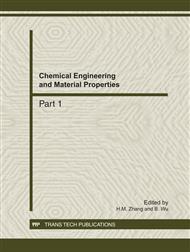p.960
p.964
p.968
p.973
p.978
p.982
p.988
p.993
p.998
Properties of LiNi0.5Mn1.5O4 /Li Cell in Ionic Liquid Electrolyte Based on N-methyl-N-propylpiperidinium Bis(trifluoromethanesulfonyl)imide
Abstract:
LiNi0.5Mn1.5O4 material was synthesized by PVP-assisted gel-combustion method and examined as a cathode material for lithium-ion batteries, working together with a room temperature ionic liquid electrolyte and a lithium metal anode. The LiTFSI-Pp13TFSI ionic liquid electrolyte was obtained by dissolution of solid lithium bis(trifluoromethanesulfonyl) imide (LiTFSI) in liquid N-methyl-N-propylpiperidinium bis(trifluoromethanesulfonyl) amide (Pp13TFSI). The LiNi0.5- Mn1.5O4/LiTFSI-Pp13TFSI/Li cell was tested by galvanostatic charging/discharging and compared with standard carbonate/LiPF6 electrolyte. At low current (0.05 C) density, the LiNi0.5Mn1.5O4/ LiTFSI-Pp13TFSI/Li cell exhibited stable cycling for 11 cycles, but it degraded rapidly in subsequent cycles. Preliminary tests showed that both the cathode and anode interfacial reaction contributed to the rapid degradation.
Info:
Periodical:
Pages:
978-981
Citation:
Online since:
December 2011
Authors:
Keywords:
Price:
Сopyright:
© 2012 Trans Tech Publications Ltd. All Rights Reserved
Share:
Citation:


